Last week, I unveiled the new brand of my business and this newsletter. Previously known as Creative Companion, I made the transition to the new name: Creator Science.
I’m proud of how smoothly the transition has gone thus far, but I wish I could have avoided a rebrand entirely – it’s a huge pain!
Not only that, but this is the second rebrand in the last two years (the newsletter was previously known as Work In Progress).

The initial transition from Work In Progress to Creative Companion wasn’t a small effort either – and in the 12-18 months since that change, I’ve built some equity and name recognition behind that name.
But, all things considered, this became more and more obviously the right move for me, despite the headaches it would cause in execution. So to hopefully save you the same pain and give you a little look behind the scenes, I wanted to share how I came to this conclusion and executed the rebrand.

What makes a good brand?
Let me start with a brief disclaimer – I’m not a designer. I’m not a brand strategist. So take my ideas here with a grain of salt.
But I’ve come to really believe in the power of brand. Even if you don’t think or care about your brand, it’s there.
It exists.
Your brand is in the minds of OTHER people. It’s the beliefs, assumptions, emotions, and ideas that come to mind when someone mentions your brand.
You want your brand to feel legitimate, trustworthy, and a whole bunch of other adjectives that vary based on your business.
I want to emphasize the first descriptor – legitimate. I don't see other people talking about "legitimacy" as the goal, but I truly believe it is.
Do you believe in things that don't seem legitimate?
Do you trust things that don't seem legitimate?
Do you buy from someone that doesn't seem legitimate?
Legitimacy is an important hurdle and one that I believe is heavily impacted by design. The design of your brand WILL be quickly judged – and if it doesn't feel legitimate, you're already fighting an uphill battle.
A good brand is both 1.) memorable and 2.) referrable.
To be memorable requires being unique enough that it's worth committing to memory.
To be referrable requires being easy to hear, read, and say. Word of mouth doesn’t happen when we can’t remember or easily say the name of your brand!
And I haven’t even touched on visual branding yet.
Someone once told me that a great visual brand should be simple enough that someone should be able to draw from memory. There are lots of examples to the contrary (ahem, Starbucks) but I generally like this idea. Again, the easier it is for someone to recall and pass along your brand, the better off you’ll be.
These brands usually have simple colors and often a limited color palette.
I also want to shout out a blog called Eat My Words created by Alexandra Watkins.
Alexandra has helped name things like the Wendy's Baconator! And she has what she calls the SMILE and SCRATCH Test for a good brand name:
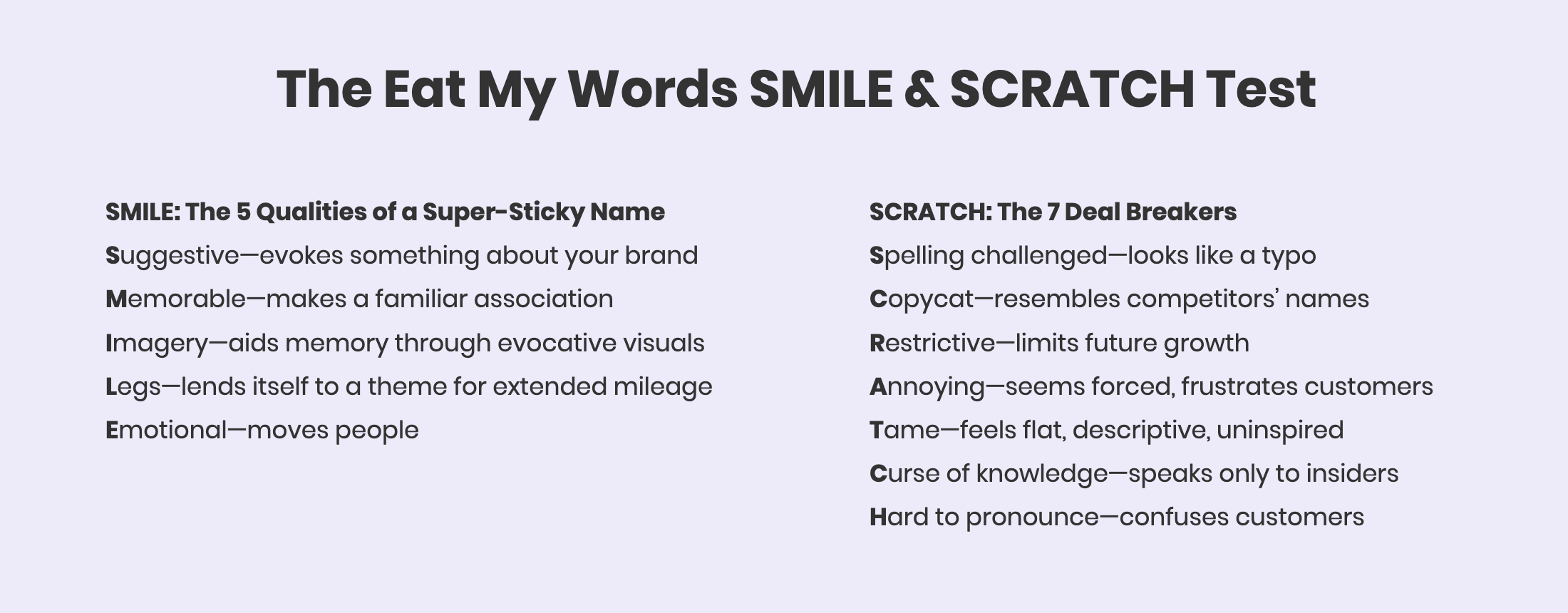
You can test your name here.
Creative Companion did not test well.
My first brand failure
Let me start with the story of the failure BEFORE this failure.
“Creative Companion” was a name I conjured out of urgency.
When I underwent the initial branding project, I was actually really enamored with the idea of playing infinite games. If you’re not familiar with the concept from James Carse, here's a quick synopsis from Wikipedia:
Carse summarizes his argument, "There are at least two kinds of games: finite and infinite. A finite game is played for the purpose of winning, an infinite game for the purpose of continuing the play.
Finite games are those instrumental activities - from sports to politics to wars - in which the participants obey rules, recognize boundaries and announce winners and losers.
The infinite game - there is only one - includes any authentic interaction, from touching to culture, that changes rules, plays with boundaries and exists solely for the purpose of continuing the game.
A finite player seeks power; the infinite one displays self-sufficient strength. Finite games are theatrical, necessitating an audience; infinite ones are dramatic, involving participants..."
Creators are usually in the business of infinite games. Sure, you could build a business to be sold – but if you’re building a business behind your name or personality, you’re likely in it for the long haul.
This sent me down the path of creating a brand related to infinite games…and I called it “Infinite Creator.”
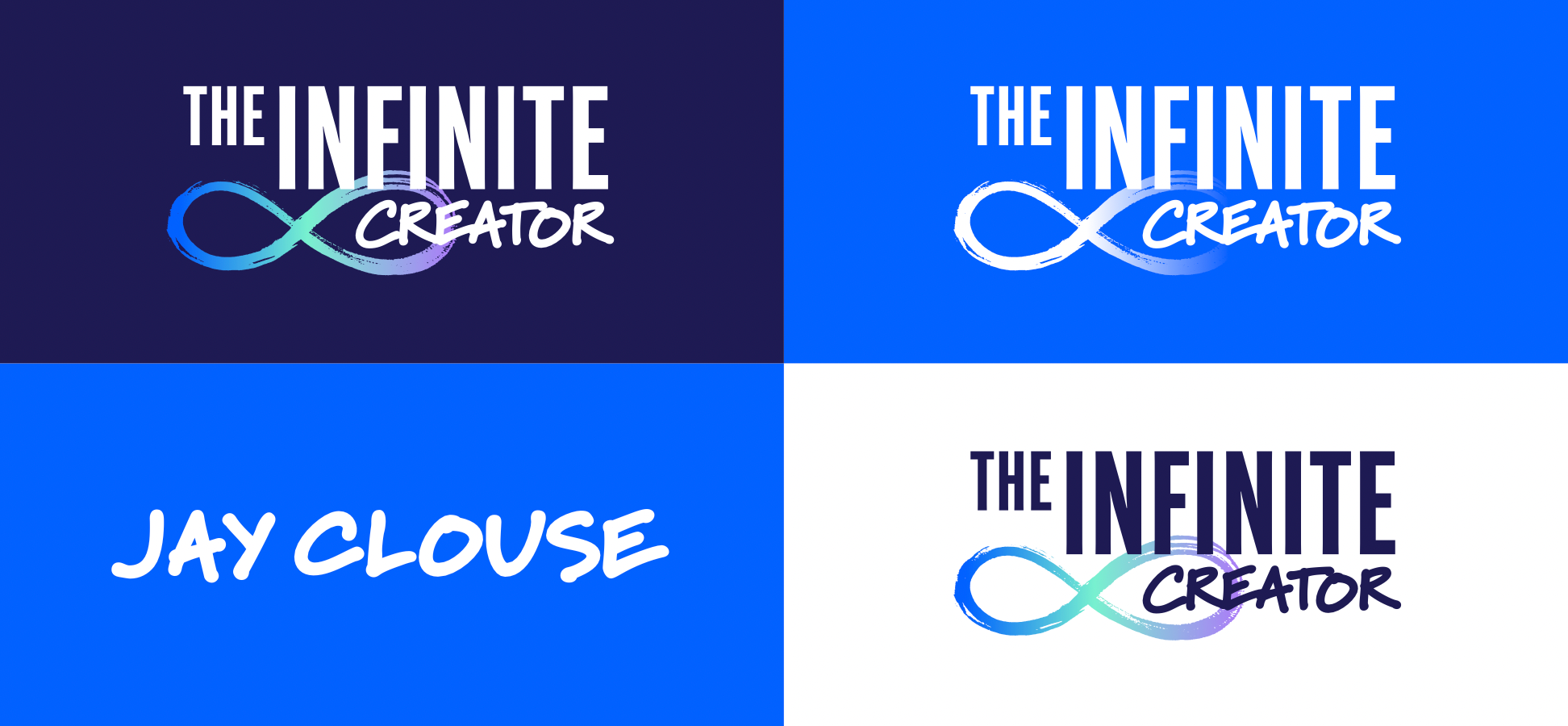
The whole brand was actually completed when I decided I should probably Google the term “Infinite Creator” just to make sure no one beat me to it.
…that’s when I realized my mistake.

I didn’t realize that the term “infinite creator” was used to refer to peoples' concept of God. It was used kind of a lot – along with an infinity symbol, which I had also incorporated into my brand.
This wasn’t going to work.
But I had already paid the design team, so I had to move quickly to get them a new name. They were kind and willing to rework the brand under the current project scope, but I wanted to make it fast so I didn’t sour the relationship.
So I began thinking of a new name and I had written something recently about how I wanted my newsletter to feel like a “companion” on your creative journey.
Creative Companion! That’s it!
We started moving forward.
Where Creative Companion fell short
As time went on, I became more and more frustrated with the Creative Companion name. There were a lot of reasons – more reasons all the time.
So, at the risk of getting too in the weeds, let me share the leading reasons because they may be relevant to your situation.
Emotional response
One thing I liked about the brand was the warmth I believe it portrayed. Companionship is a cozy thing. And to be a companion on what I see as a LONG journey for someone felt very aligned to who I am as a person.
But I was very close to the brand.
When I shared the name of the newsletter with people directly or online, the universal response was basically ¯\_(ツ)_/¯
No one cared.
It didn't elicit any type of emotional response at all – positive, negative, curious...just pure indifference.
And indifference is the worst response possible.
I've dabbled with paid acquisition and intentional cross promotions over the last few months, and I've compared notes with other creators who experimented with the same outlets (a really great strategy that I learned from Polina Pompliano):
My newsletter performed more poorly than others – which really comes down to how compelling the newsletter 1.) name and 2.) description is.
Once again, the indifference was deafening.
Compare that to Creator Science, which immediately receives curiosity, excitement, and usually enthusiasm.
Legitimacy
Dovetailing off of the poor emotional response, I came to believe that Creative Companion also didn't feel very legitimate.
When I think about legitimacy, I mostly think through the lens of where this [thing] can be spoken about:
- Podcast introductions
- Other blogs
- The name of a keynote talk
- The title of a book
Really great brand names lend themselves to those different modalities.
"Jay is the writer of the Creative Companion newsletter..."
"Jay is the founder of Creative Companion..."
"Creative Companion, a talk about ____"
"Jay is the author of Creative Companion..."
It just felt meh. And wasn't at all suggestive of what the content was about (other than creativity – which isn't differentiated or super compelling).
Comparing this to the new brand of Creator Science – these modalities all feel like a home run.
Prospects for acquiring the .com
When I decided that "Creative Companion" was the path forward, I looked to buy the domain name. Unfortunately, the .com AND the .co were taken.
I talked myself into buying creativecompanion.club and creativecompanion.blog.
The reality is, other Top Level Domains (TLDs) like .club and .blog are just as visible on the internet via search results.
Visibility isn't the problem.
The problem is referrability. Every time I wanted to direct people to my website, I had to orally say "creative-companion-dot-club." It doesn't seem like a big deal at first, but it actually requires the person hearing to listen more closely and have a better memory. They aren't just remembering your brand name, they must also remember the TLD they need to type in to take action.
And when it comes to legitimacy, nothing looks more legitimate than a .com.
Sometimes, even if you can't immediately buy the .com for your brand, it isn't currently used. It could expire or you could acquire it from the current holder.
Unfortunately for me, creativecompanion.com is in use by the National Education Association.

Trademark-ability
Not only did the NEA have the .com, but a basic trademark search showed that they trademarked the name as well.
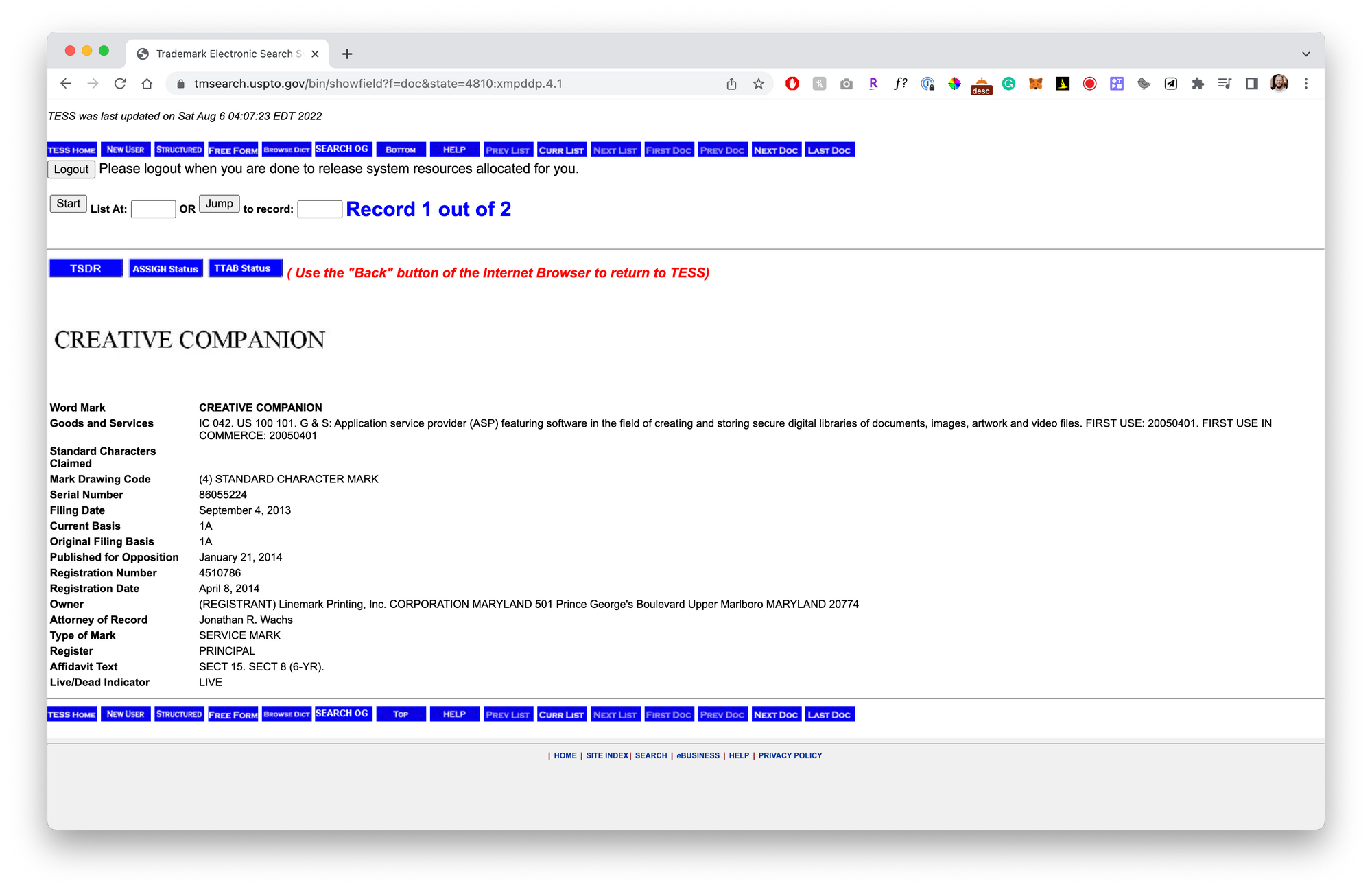
It could probably be argued that our businesses are different enough that my use wouldn't infringe on their trademark...but did I want to fight that?
As my business grows, I'm investing more effort into investing in protecting my assets over the long term. And my own prospects for protecting the name weren't looking good.
Audience alignment
The final nail in the coffin came from Twitter.
I asked my followers (the people who arguably know my work the best) what words they associate with me and my work:
What words or ideas do you associate with me or my work?
— Jay Clouse (@jayclouse) April 27, 2022
The responses were kind and insightful – but they weren't what I was looking for.
One of my goals is to be one of the first people that comes to mind when someone wants to learn about the creator economy.
Every day, people are tweeting lists about the "Top X people to follow if you're interested in [topic]" and I want to be one of the obvious people to include in lists about the creator industry.
But the responses to my tweet rarely mentioned the word "creator" at all.
There was a misalignment between my brand perception and brand aspiration.
What if I put "creator" right in the brand name?
When to rebrand
You may be asking, if I've never been in love with the Creative Companion brand, why didn’t I make the switch earlier?
Well, the most obvious answer is that I needed to have an alternative that I DID really like. As I shared before, this process isn’t fun or easy – and the less often you do it (hopefully never) the better off you’ll be.
It isn't worth making a change until you are confident you've come to a better long-term solution.
But there are more reasons why rebranding may not be the right move for you.
There is a significant cost to rebranding – both in terms of time and even cash for design help or trademark protection.
To do this well, I knew I wanted to involve a design team to make the visual brand look legitimate. My audience is creative people – so if my visual brand doesn’t appeal to them, then I’m losing right off the bat!
How I executed the rebrand
As long as this post already is, this section alone could dwarf the rest of the piece. So I'll give an overview and a bit of detail for each step here, but feel free to comment below with follow-up questions you have if you want to go deeper.
Finding a new name
I knew I wanted a new name before I had identified what that name was.
So I started by creating a page in my Notion database to capture potential names. I liked the word "creator" but I was also open to ideas related to publishing or other aspects of being a creator. I really like the site relatedwords.org for this.
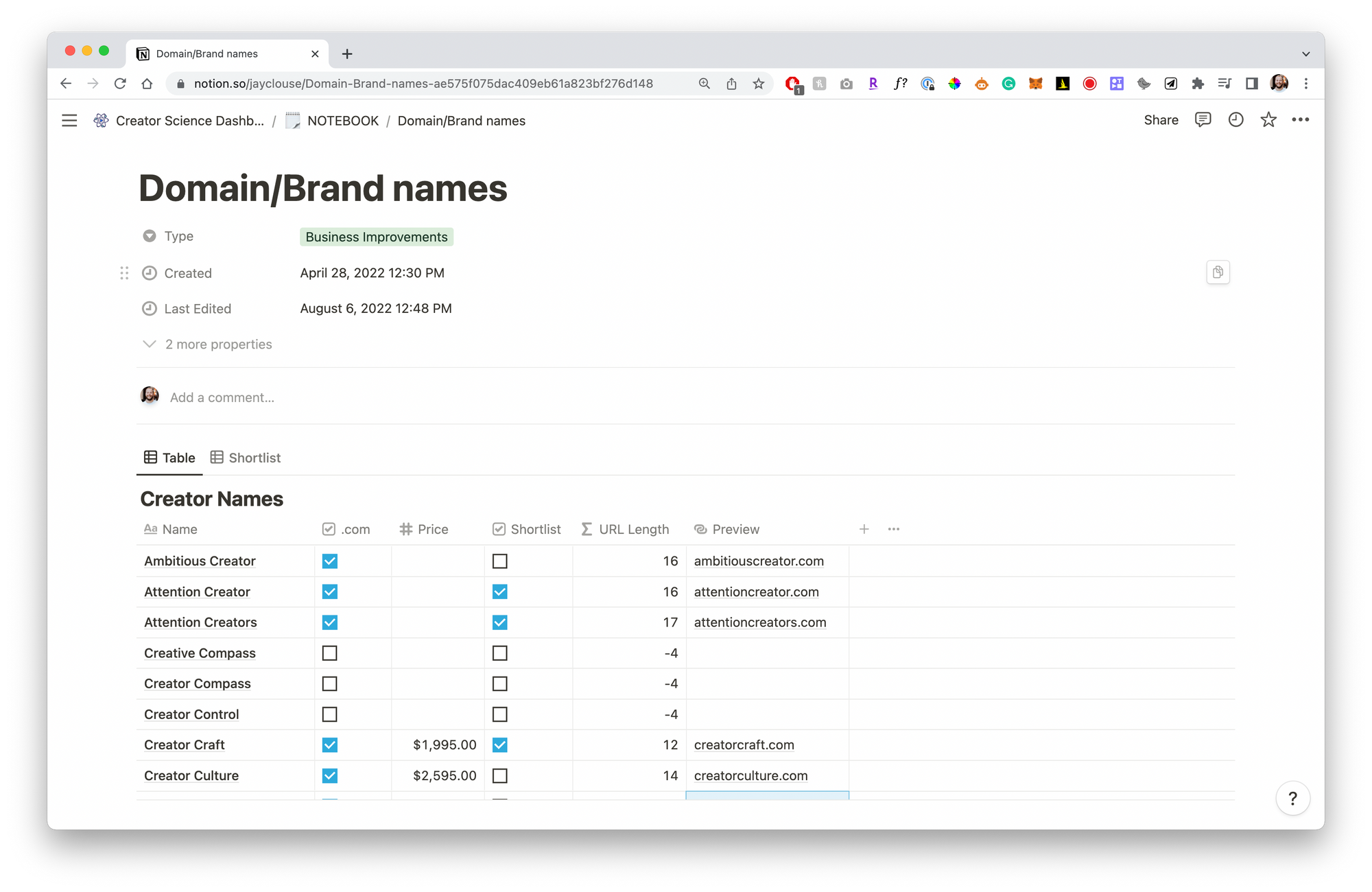
In this list, I noted whether the .com was available, the price to acquire it (if it was a premium domain), the length of the URL, and a preview of what that URL looked like when typed.
This list had 46 total ideas, which I narrowed down to a shortlist of 11. Of that shortlist, I also looked into trademark competition.
I landed on Creator Science because I believed it had the strongest underlying message, it elicited emotional responses in the people I shared it with, it suggested something about the content, and it checked a lot of boxes in terms of availability.
Creator Science turned out to be a premium domain. I paid $1,361 to acquire the .com but also went ahead and purchased .co, .org, .club, .xyz, .tv, and .net.
I also acquired social media handles (which were also available).
Socialize the name with close friends
Truth be told, I purchased the digital assets before I told anyone about it.
I knew I liked the idea and was likely going to run with it – but I was still willing to walk away if the universal response from my close friends was negative.
I spoke with people I trusted – people who were thoughtful and also willing to tell me if they believed I was making a mistake.
And some people DID tell me I was making a mistake!
Others absolutely loved it.
In either case...I received a strong emotional response.
Socialize the name with the community
Now that I was even more bought in on Creator Science, I needed to get feedback from my community – literally the Creative Companion Club community.
A rebrand of the newsletter necessitated a rebrand of the community...and that was really scary for me.
What if they didn't like it?
What if it no longer felt like a place they wanted to be?
So I shared a post in the community asking for feedback:

I was blown away by the quality and depth of feedback people gave me. Several members recorded their own Loom videos so I could actually SEE their reactions.
Here's the actual video I shared if you're curious to watch it:
And, once again, the responses were strong. Some of them were pretty strongly opposed – the term "science" felt cold in comparison to the warmth "companion" evoked.
But that emotional response was what mattered to me – and ultimately, weighing the positive vs. the negative, I decided to move forward.
Engage a design agency
I re-engaged the Brave Little Beast team who have helped me now with Freelancing School, my personal brand, and the original Creative Companion.
I know these guys, they know me, and we already have a strong base of shared understanding (and literal creative assets to build from).

They were gracious enough to make time for me, so I recorded a quick creative brief on Loom. This is another benefit of having history with this team – this brief is literally all I gave them as a starting point because they already knew me:
From there, I spent a lot of time thinking about iconography that supported the juxtaposition of both "science" and "creator."
I had a lot of fun finding visuals that relate to science and deciding where the line of too science-y is.
It was a lot of icons like this:

Ultimately, I decided that the concept of an atom was the right balance of related to science while still having space to feel "creative" vs. pure lab coats.
And to relate it even more to creators, I thought a play button in the center would be a nice touch.
Involve the community in the process
As Brave Little Beast and I worked through revisions, I continued to to involve the community and ask their opinion.
Just for fun, here's where the initial concepts started:

And the community was super helpful! They continued to keep me focused on being not too science-y, but to maintain priority on legitimacy.
We had three different posts in the community going through the revision process and it was an absolute blast to involve the members so directly in the entire transition.
Design new website
Creative Companion was the first time I really tried using Ghost as my website builder. I liked Ghost because it was optimized for speed and also could be used as member management for my membership community...but the learning curve was kind of steep.
Ultimately I chose a theme called Ubud and did some customization to land here:

I liked it, and it worked fine, but it felt too much about me and not enough about the newsletter. When I think of newsletter brands, I think of landing pages optimized for new subscribers and really leaning into the value of the writing:
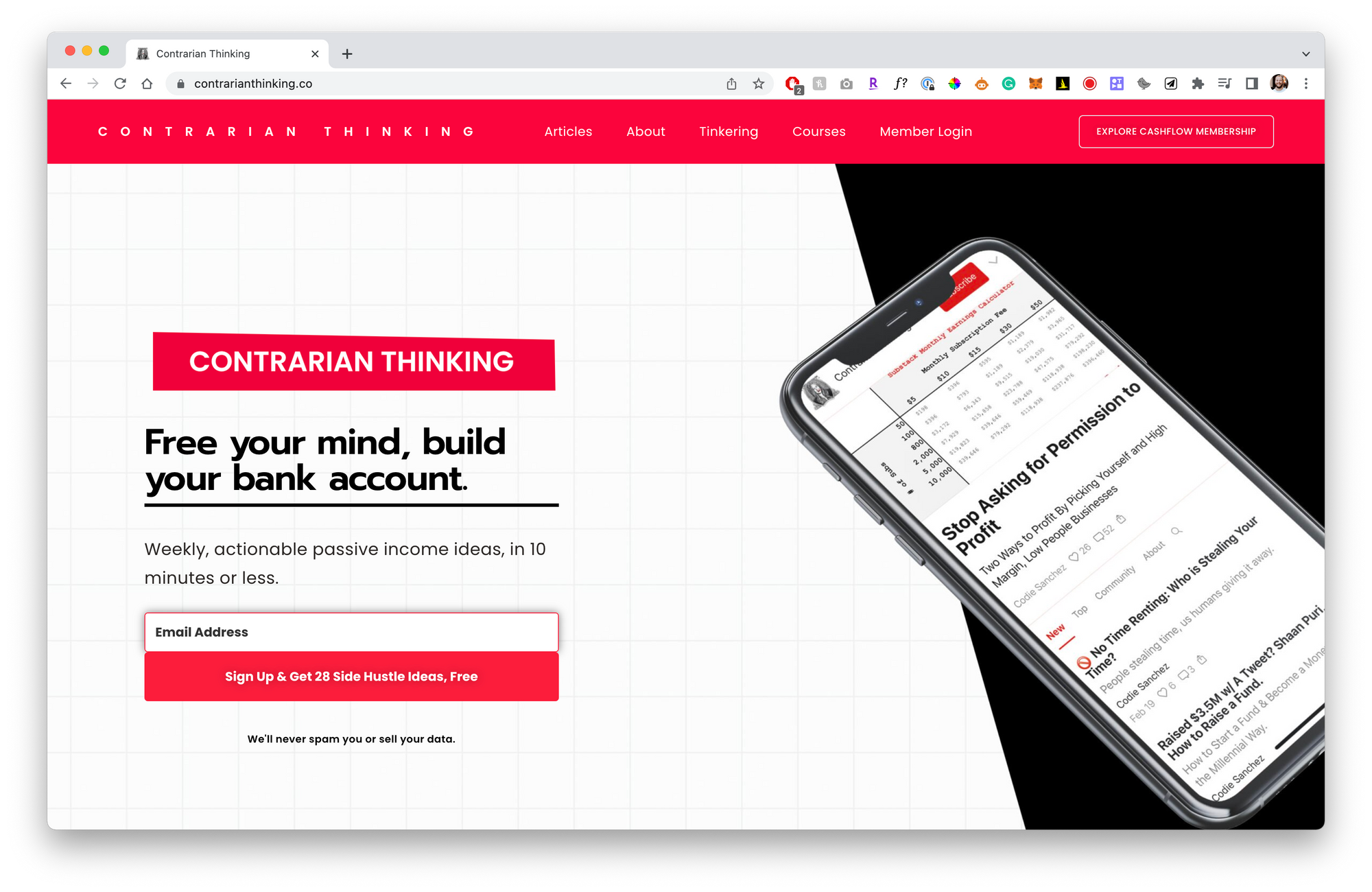


So I spent some time finding a better alternative theme for Creator Science that was more focused on the writing and content than me, my face, or my history.

It still took quite a bit of customization, but I'm really happy with where it landed!
Before I launched the new website, I was customizing the theme on a staging website using Ghost Pro hosting. Ultimately, I self-hosted the Ghost website using Gloat from Dan Rowden. Dan was instrumental in helping me make the transition from one URL to another and setting up the correct redirects. I recommend you hire him!
Make a prioritized "switch" list
Even once I had the visual brand done and a theme that I was happy with, actually switching over to the new brand was a lot of work. It was basically all I focused on for a full week.
Why?
Because there are a ton of links and references out there of Creative Companion. For any link and reference I could control, I wanted to make that switch as quickly as possible. For links I couldn't control, I wanted to ensure that I had redirects setup from past URLs to the new URLs so that people visiting could still land in the right place.
I'd done a lot of work to socialize Creative Companion! I didn't want that to go to waste.
Here's a quick look at the list of things I had to address:

If it looks like a lot, let me assure you – it felt like a lot too.
Still to come
I think I’ve only done about 20-30% of the effort necessary to socialize this rebrand. It's not only about getting the new name out there – it's actually about socializing to my existing audience that this change has occurred.
Even your biggest supporters often need to be told something several times before they notice or understand it.
Part of the reason I wrote this post was to reinforce the fact that the brand has changed. And in order to get people to pay attention to this announcement, I decided to focus on framing this as a useful article for a future brand or rebrand launch that YOU may deal with.
But now that this is live and everything has been switched over, I can stop limiting the amount of outreach I'm doing. I can put more focus into sourcing collaborations.
This is the time when I feel like I can really focus on leveling up and growth.
If you're enjoying Creator Science, I'd love for you to share it! You can share this article or just the website. If you aren't already subscribed, I'd recommend subscribing here.
And if you want to work alongside other creators like me who are serious about leveling up their businesses, you should consider joining The Lab – the new name for our membership community.
Hope to see you inside!


